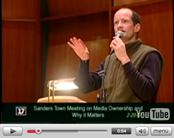Beating a Woman to Death
This article below, posted by Neil Anderson, is probably public relations from the gaming industry, which is bigger than the movie industry, and even less responsible.
-- To suggest that all the carefully controlled video game studies are obsolete and to minimize the careful work of many independent researchers is an injustice that flies in the face of reality. The violent video game parasites continue to exploit our most vulnerable youth.
-- Anyone who is seriously interested in this research, so cavalierly dismissed, can read my summary of this research in Adolescent Medicine Clinics (2005). Since '05, the effects research has only grown stronger. The upcoming 2nd edition of the college text, Children Adolescents and Media, will include a current summary (and my review of media literacy research).
-- Kutner and Olsen blast video game violence studies for their shortcomings, yet their own "study" uses an unimpressive and relatively simple survey. When it was presented at the Society for Adolescent Medicine, a number of major medical researchers walked out over its manifest inadequacies.
-- The book suggests that kids felt better after they "blew up a few cars and shot a half-dozen people, including a young blond woman. When asked, young Darren admits that the woman he killed in the game looked a lot like his teacher." (Well, isn't that just special?)
-- Why just shoot her? Why not beat her to death with a golf club, amidst blood and gore? That actually happens in Grand Theft Auto.
-- Do you want your kids to do this?
-- The notion that Darren feels "better" after committing virtual mayhem is "catharsis" theory which has been proven to be junk psychology innumerable times.
-- Most screeds like this are financed by the video game industry. I don't know if this one was, but it follows the industry's number one PR talking point: It is never the industry's problem. To them, providing ever more realistic ways to kill, maim and bomb other humans is just good fun, does no harm, to anyone.
-- The industry always says that kids don't see their "characters" as "role models." Obviously, that depends upon the age and maturity of the kids, but to use it as a sweeping generalization flies in the face of much effects research.
-- If as media educators, you adopt this line of reasoning with parents, down the road be prepared to meet the parents of Michelle. Michelle is a real girl.
-- I met her in one of my workshops at the Albuquerque Juvenile Detention Center. She was middle class, bright, attentive, attractive and pleasant. Afterwards, I asked one of the guards what she was in for. He told me the following story:
-- One day Michelle skipped school to get drunk and high with a friend. Dropping her friend off after school, her mean science teacher (who reminded her of an uncle who had groped her) walked in front of her car. She punched the accelerator. Now she is a murderess.
-- It took very little to push Michelle over the edge. It takes very little to push gang kids with guns and drugs over the edge. Last weekend, in Chicago, about a dozen kids went over the edge--record numbers of murders, same thing in Philadelphia.
-- Hundreds of careful, responsible studies estimate that media violence causes 8-24 per cent of youth violence.
-- Still want your kid to beat that woman to death? Are our kids getting more polite, less abrasive and more cooperative? We cannot do much about poverty and the other causes, but we sure could do more to control the violent media culture.
Bob
Presenter, Media Educator, Consultant
www.bobmccannon.org
Author, "Media Literacy/Media Education
Literature Review" in Children Adolescents
and Media, 2nd edition - college text, due:
July, 2008
Co-President, Co-Founder
The Action Coalition for Media Education,
www.acmecoalition.org
2808 El Tesoro Escondido, Albuquerque NM 87120
mccannon@flash.net (505) 839-9702
Executive Director, 1993 -2005
The New Mexico Media Literacy Project (founded 1993)
On Apr 28, 2008, at 6:04 AM, Neil Andersen wrote:
Violence and video games
TheStar.com - entertainment -
April 28, 2008
Lawrence Kutner
Cheryl K. Olson
Special to the Star
The following is excerpted from Grand Theft Childhood, by Drs. Lawrence Kutner and Cheryl K. Olson, co-directors of the Harvard Medical School Center for Mental Health and Media. They weigh in on a longstanding debate: the relationship between video games and teen violence. The book, published this month, is timely: Grand Theft Auto IV, the latest installment of the mega-selling and much-criticized series, goes on sale at midnight.
Thirteen-year-old Darren and a half dozen of his video game-playing friends are sitting around a table at the Boys and Girls Club in a working-class section of Boston. We're talking about the games, especially the violent ones. They've all played them.
Darren had a tough time in school earlier this week. On Monday, a teacher said something that embarrassed him in front of his classmates. When he went home that afternoon, he plugged in his video game console, loaded Grand Theft Auto III, blew up a few cars and shot a half-dozen people, including a young blond woman. When asked, Darren admits that the woman he killed in the game looked a lot like his teacher.
If you listen to the politicians and the pundits, the relationship is blindingly clear: playing violent video games leads children to engage in real-world violence or, at the very least, to become more aggressive.
In August 2005, the American Psychological Association issued a resolution on violence in video games and interactive media, stating that "perpetrators go unpunished in 73 per cent of all violent scenes, and therefore teach that violence is an effective means of resolving conflict."
The attorney for Lee Malvo, the young "DC Sniper," claimed that the teen had taught himself to kill by playing Halo on his Xbox game console. "He's trained and desensitized with video games ... to shoot human forms over and over."
Columbine High School shooters Eric Harris and Dylan Klebold were avid computer gamers. According to psychologists Craig Anderson and Karen Dill, "One possible contributing factor (to the incident) is violent video games. Harris and Klebold enjoyed playing the bloody shoot-'em-up video game Doom, a game licensed by the U.S. Army to train soldiers to effectively kill."
We hear that youth violence, as reflected in violent crime and school shootings, is a growing problem, and that young game players are socially isolated and unable to form interpersonal relationships.
The growth in violent video game sales is linked to the growth in youth violence – especially school violence – throughout the country.
School shooters fit a profile that includes a fascination with violent media, especially violent video games.
A British study by Save the Children was described in the press as finding that "children are struggling to make friends at school because they spend too long playing computer games." A spokesperson for that organization added, "Children have always played alone, for example with dolls or train sets, but these activities required a certain level of imagination – they stimulated their brains. That is not the case with modern computer games, which do children's thinking for them and put them in their own little world."
All of these statements are wrong. In fact, much of the information in the popular press about the effects of violent video games is wrong.
The real puzzle is that anyone looking at the research evidence in this field could draw any conclusions about the pattern, let alone argue with such confidence and even passion that it demonstrates the harm of violence on television, in film and in video games. The allegation that "perpetrators go unpunished in 73 per cent of all violent scenes" is based on research from the mid-1990s that looked at selected television programs, not video games.
The video game Halo involves shooting an unrealistic gun at a giant alien bug. It is not an effective way to train as a real sniper. In court, Lee Malvo admitted that he trained by shooting a real gun at paper plates that represented human heads. Also, Malvo had a long history of anti-social and criminal behaviour, including torturing small animals – one of the best predictors of future violent criminal behaviour.
It's unlikely that Harris and Klebold's interest in violent video games or other violent media played any significant role in their actions. An FBI investigation concluded that Klebold was significantly depressed and suicidal, and Harris was a sociopath.
Video game popularity and real-world youth violence have been moving in opposite directions. Violent juvenile crime in the United States reached a peak in 1993 and has been declining ever since. School violence has also gone down. The U.S. Secret Service intensely studied each of the 37 non-gang and non-drug-related school shootings and stabbings that were considered "targeted attacks" that took place nationally from 1974 through 2000.
The Secret Service found that there was no accurate profile. Only one in eight school shooters showed any interest in violent video games; only one in four liked violent movies.
On the other hand, reports of bullying are up. Our research found that certain patterns of video game play were much more likely to be associated with these types of behavioural problems than with major violent crime such as school shootings.
For many children and adolescents, playing video games is an intensely social activity, not an isolating one.
Many games involve multi-person play, with the players either in the same room or connected electronically. They often require that players communicate so that they can co-ordinate their efforts. Our research found that playing violent video games was associated with playing with friends.
For younger children especially, games are a topic of conversation that allows them to build relationships with peers.
Although it came from a reputable organization, the widely cited British study claiming that increased use of electronic media has led to social isolation among children based its findings on the personal opinions of an unspecified group of primary school teachers who were asked to compare today's children (ages 5 to 11) to what they remembered about children who were in their classrooms when they started teaching, not on scientific observations of children conducted over time.
As Darren tells his story about feeling angry, then playing the violent video game in which he blew up cars and shot several people, including one who looked a lot like his teacher, the other kids sitting around the table nod their heads. It's clear that at one time or another, they have each done something similar.
"I guess I got my anger out," Darren says. "Then I sat down and did my homework."
>From Grand Theft Childhood by Lawrence Kutner and Cheryl K. Olson. Copyright 2008 by Lawrence Kutner, PhD, and Cheryl K. Olson, Sc.D.f. Reprinted by permission of Simon & Schuster, Inc.



![View your cart items []](/sites/default/modules/ecommerce/cart/images/cart_empty.png)




